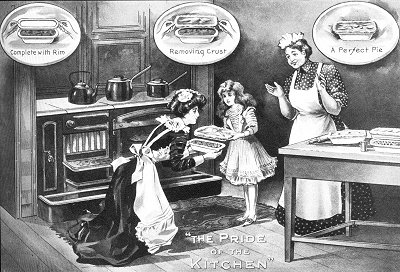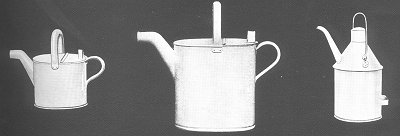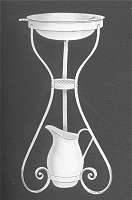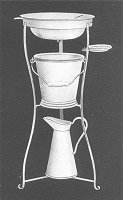MACFARLANE & ROBINSONstamped steel enamelled hollow-ware and sign plates etc..A look through the catalogue (1)We do not show here every item on every page of the catalogue - there are more than eighty fully illustrated pages and a complete reproduction is beyond the present capacity of this virtual museum. The catalogue starts with the standard range of household items: wash basins, washing bowls, soup bowls, pudding bowls and bowls of every sort and size, and pie and cake pans. Then the company is carried away with enthusiasm for their patent pie dish and provides the only picture of their products in use:
Recovering its equilibrium, the catalogue continues with plates and dishes, mugs and tumblers and a child's toy tea set,
to this sugar bowl, cream jug and tea or coffee strainer. And then:
this sailor's butter dish, an ordinary butter dish and a sauceboat. Anything in the catalogue that had a wide base, and seemed less likely to fall over when rocked, is said to be for sailors or ships.
And here are three sorts of soup tureens. Then on to jugs of all shapes and sizes:
such as these ewers. Next, in a reminder that beer did not come in cans and bottles but was fetched from the pub, we have
two beer cans and something on the far right called a "froth jug". The dotted line must show some insert which keeps the froth at bay when pouring.
And then we have this hot water can, toilet can and oil can. The first two remind us that plumbing then is not what plumbing is now and water, hot and cold, had to be traipsed around the house, preferably by a servant. Onwards through spice boxes, cruets, funnels, ladles and spoons of all sorts, cullenders, sieves, measuring jugs, vegetable dishes, pudding moulds, teapots (including, of course, a teapot for ship's use), coffee pots and so to storage:
in large sizes for bread and flour and a range of sizes for provision jars. You could have any lettering you liked on these, if you paid extra, but the stock lettering was: salt, sugar, barley, tapioca, tea, coffee, rice, sago, raisins, currants, peas, lentils, haricot beans, loaf sugar, split peas. This was probably a pretty standard range of dry goods and, even if not all of them sound wonderfully tasty to those brought up on frozen peas and Angel Delight, they were, no doubt, thought not merely useful at the time. And so on to some rarer items such as a brawn pan, various scoops and then, between the confectioner's show tray and the chamber pots and commode pans, a photographic developing tray.
To remind us further that the sanitary arrangements were not all we might expect today, we have these toilet pails:
The catalogue then moves on to "superior quality" wares, which are mainly the same sort of things as in the standard range. It is not stated what is superior about these wares - better enamel? thicker metal?
Anyway, these egg poachers and a potato steamer will represent them. The catalogue now progresses to more colourful items. |














